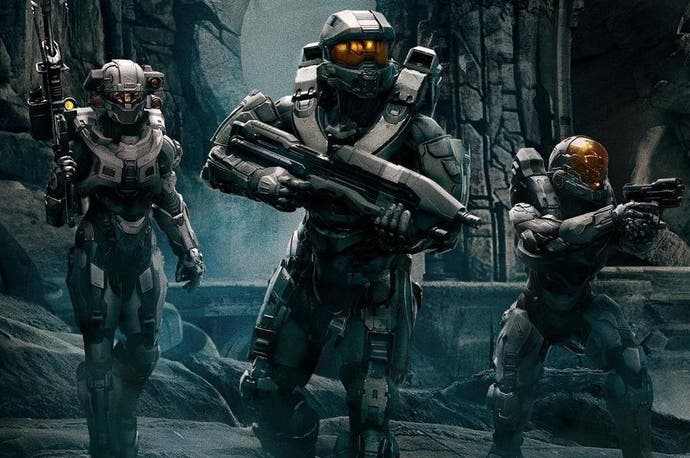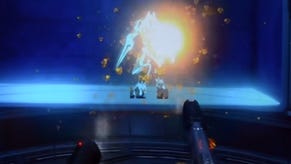What works and what doesn't in Halo 5: Guardians
Digital Foundry presents its final analysis of the Master Chief's full Xbox One debut.
When it comes to Microsoft's presence in the console space, there is no franchise more synonymous with the Xbox brand than Halo. The original Halo: Combat Evolved redefined the first-person shooter for the console space and helped to make the Xbox brand a success. However, when Bungie, the creators of Halo, stepped away from the franchise in 2010, Microsoft was left with no choice but to build a studio capable of taking Halo forward. That studio is 343 Industries and with Halo 5: Guardians, we get our first taste of the genre-defining shooter running on the latest generation of console hardware.
Of course, building upon a franchise made popular by another creator is never an easy task. 343 Industries was tasked with creating something that caters to both long-time fans and newcomers alike. Blazing a new trail while pleasing the old guard is never easy and the release of Halo 4 in 2012 left many wondering if 343 could really capture classic Halo - particularly following its disappointing multiplayer component. This was followed by last year's Halo: the Master Chief Collection, which only served to fuel those concerns through a pile of technical shortcomings and server problems.
The answer to those criticisms is Halo 5: Guardians. Throughout its development, 343 has maintained a dialogue with the community in an effort to really deliver what the fans desire. Gamers were given an early peek at the game with the Halo 5 beta almost one year ago, a test which helped shape the final game, and 343 was never shy to share their vision of the game with the fanbase.
The decision to target 60fps gameplay across the entire game is the boldest decision 343 takes in redefining Halo for the new generation of console hardware. While the Master Chief Collection and PC ports of the first two Halo games have given us a taste of 60fps action, the latest installment in the franchise is the first game in the series to deliver such a high frame-rate at the outset. A less than ideal frame-rate never seemed to hold the series back before but the decision to aim for 60fps in the new game benefits everyone in the end.
But there's no free lunch when it comes to rendering, and attaining the silky-smooth update demands compromises. It's a challenging target to hit in developing any game but when approaching an FPS, the demands placed upon the creators increase dramatically. While we have plenty of 60fps shooters on the market today, very few of these games actually deliver a completely stable frame-rate. There are the rare exceptions out there, such as Metal Gear Solid 5 and Metro Redux, but capturing this fluidity in a shooter such as Halo with its huge numbers of actors, physics, and effects in play is no small feat.
According to 343, the Master Chief's latest outing was built on a new engine and we were curious to see how this target would impact a new Halo experience. Bungie's games were only possible as a result of the lesser performance target - can Halo 5 really deliver the full Halo experience at 60 frames per second?
What works
- Frame-rate: Without a doubt, the defining technical feature of Halo 5 is its frame-rate. Delivering a stable 60 frames per second across the board, Halo 5 feels marvellous to play. During normal gameplay, only the occasional duplicate frames manifesting at checkpoints have any impact on fluidity. The only question mark hanging over the game is the upcoming Forge mode - which allows users to craft map variants from a huge selection of objects. This feature has yet to be released and, as a result, it's impossible to say how performance will look here. In previous Halo games, no other mode could drop the frame-rate quite like Forge so we're eager to see how it turns out in Halo 5.
- Dynamic resolution: It's clear that hitting 1080p while maintaining 60fps would not have been possible in Halo 5 but rather than simply opting to render at a low resolution across the board, 343 has implemented one of the most impressive dynamic resolution scaling systems we've seen to date. In Halo 5, X and Y values are adjusted independently enabling a wide range of values designed to maximize performance. The lowest recorded value we find is 1152x810 but we see arbitrary values such as 1168x810, 1440x840, 1344x972, and 1536x1080 as well. Halo 5 is able to make these adjustments on the fly while avoiding over budget frames throughout, ensuring silky-smooth performance.
- Menu system: It may seem trivial, but the quality of the menu experience is a hallmark of the franchise under Bungie. Typically combining smart typeface choices with beautiful, animated backdrops, the Halo menu systems are traditionally functional yet beautiful. Halo 5 manages to update this tradition expertly. The Halo 5 menu system is both beautifully designed and well performing. Transitions between each section of the menu happen smoothly with simple transitions, backed by an excellent soundtrack worthy of the series. We feel this is a significant upgrade over the somewhat inconsistent user interface present in the Master Chief Collection.
- Cut-scenes: Storytelling has always been a key element to the Halo experience and Halo 5 delivers the most technically impressive cut-scenes in series history. While the intro and outro sequences are pre-rendered videos, the overwhelming majority of cinematic sequences in the game are rendered completely in real-time. With high quality shader and materials work in effect along with excellent bokeh depth of field, performance captured animations, and impressive lighting, Halo 5 looks its best during these 30fps sequences.
- Audio: Halo 5 delivers an expertly constructed 7.1 audio mix that envelopes the player in a convincing sound-field. While weapon effects and general carnage all sound excellent, it's the smaller details that really stand out. Spartan charge into a wall and listen carefully as the resulting debris produces convincing metallic sounds as they collide with the floor. On top of this, we have the excellent soundtrack which weaves in themes from Halo's past with its own unique flavour. Halo 5's audio experience is certainly one of the best of the year.
- Loading times: Getting into and out of multiplayer matches requires quick swift loading times and thankfully, that's exactly what Halo 5 provides. Both the campaign and multiplayer matches require no more than a few seconds to load keeping wait times to a minimum. While the loading screens themselves are not as lavish as Bungie's, the wait times are fast enough that this never sticks out.
- Physically-based materials: Halo 5 adopts a physically based approach to rendering which takes into account the roughness of the material and how it interacts with light. Materials now exhibit more realistic diffusion and reflection properties, among other things, and the game benefits greatly from this. Metallic surfaces appear more realistic while highly diffuse materials, such as sand and stone, behave as you would expect. However, it's not completely successful across the board, with many materials exhibiting an overly plastic or polymer-like appearance.
What doesn't
- Image quality: While the dynamic resolution system is impressive, the reality is that the game spends the overwhelming majority of its time well under full 1080p. When combined with sparse anti-aliasing coverage this often results in scenes exhibiting aliasing and blurring artefacts simultaneously. This is further impacted by limited texture filtering, smearing surface textures at oblique angles. In fact, the selected texture filtering has a stronger impact on overall presentation than resolution.
- Half-rate animation: While the game operates at 60fps, active entities within the world will actually animate at half-rate when they reach a set distance from the player. We're basically seeing 30 frames of animation per second while the game continues to operate at 60 in these situations. Halo 5 often places huge numbers of entities within each scene. You can have multiple Spartans fighting alongside locals against a huge hoard of enemy forces. In the busiest of scenarios, we see more active on-screen enemies than in any other Halo game. Yet, managing so many actors in a scene places additional strain on the CPU which could drop performance. It would appear that this system was implemented to prevent such a load from tanking the frame-rate. It's successful but, more than any other sacrifice made, it looks rather jarring during normal gameplay. The distance in which enemies begin to animate at half-rate is just a bit too close to the player for our liking.
- Lighting and shadows: Halo 5 makes heavy use of pre-calculated lighting in order to improve rendering speed with more dynamic shadows and light sources limited to active elements within the scene. In order to improve rendering speed, a number of tricks are employed here that have an impact on visual quality. For instance, dynamic shadows are regularly culled from view near the player, while shadow maps exhibit noticeable jagged artefacts. The greater issue is the way in which the game swaps between the different levels of quality. The constant adjustments being made ultimately create a sense of instability across the world.
- Alpha effects: Smoke, fire and other alpha blended operations require more from the GPU and can drop the frame-rate in close proximity to the viewport. 343 has taken two different approaches to this problem. Firstly, alpha effects used during gameplay are rendered at a lower resolution much of the time. This requires less from the GPU and as a result, performance remains smoother. Environmental effects use a different approach - when the player's view is in close proximity to any sort of constant alpha effects, the effects in question are culled from view.
- Texture quality: Despite the move to a more realistic materials system, the actual resolution of many assets leaves a lot to be desired. Throughout the game we stumbled across low resolution textures and normal maps applied to key surfaces. The prevalence of these textures contrasts with otherwise high resolution assets leading to an inconsistent appearance. The surface of Meridian in particular stands out as an area that needs additional work with chunky, low resolution tyre tracks impacting an otherwise beautiful scene.
- Level of detail: As in many games, object detail is adjusted based on proximity. This means that models use lower quality assets from a distance with higher quality models swapped in as players moves closer. The issue here is that these LODs often appear too close to the player and lack any sort of transition. Debris is also used liberally throughout the game to add extra detail to the terrain. As in previous games, a type of dithering is used to transition these elements into view. In Halo 5, many of these elements continue to exhibiting dithering patterns even when the player is standing right on top.
- AI: The Halo franchise has been known for its impressive artificial intelligence since the beginning and while the enemies in Halo 5 fare pretty well, there is a sense that enemies can't quite stand toe to toe with Bungie's best. Enemies feel less dynamic overall with a focus placed more on dealing with large numbers of them rather than individual, intelligent units. Friendly AI is generally pretty good but it does struggle with pathfinding while driving the player around in a Warthog. Ultimately, it's only when comparing to Bungie's work that we feel a bit of disappointment in this area.
- Multiplayer map selection: The maps included in Halo 5's multiplayer mode left us a little disappointed as well. Visually speaking, the maps tend to focus on 'facility' type areas rather than the greater variety we were used to seeing in classic Halo. Crucially, the maps still play well, though sight lines feel a bit limited at times, but our initial take is that they lack the personality and visual panache we've come to expect in the series. From our perspective, even the selection of maps in Halo 4 feel more exciting from a visual perspective.
Halo 5: Guardians - the Digital Foundry verdict
Halo 5: Guardians is an important game for 343 Industries. It's clear that fans are ready for a new Halo experience, regardless of any harm that may have been done to the brand with the Master Chief Collection. Our time with the game suggests that the developer has done a good job of meeting expectations overall. Halo 5 does not offer cutting-edge visuals but it does bring fast, smooth performance to the table which means more responsive gameplay. It's still a handsome game in its own right and with a focus on performance, one that takes a different path from most games released today.
We certainly enjoyed playing through Halo 5 but there are some gameplay related nits to pick that keep it from matching the sublime experience we typically associated with Bungie's series entries. Human weapons, for instance, still seem prone to running dry, forcing players to scavenge whatever the enemy of the moment is using instead. We were also disappointed with the approach to level design in the campaign. Similar to Halo 4, each level consists of a series of arenas strung together by hallways. While the quality of each arena is a huge step up from Halo 4, we never seen anything on par with the Scarab battles from Halo 3 or the Silent Cartographer from Halo Combat Evolved. With the engine clearly capable of delivering such large maps, this feels like a missed opportunity.
After the post-launch disasters of Halo: the Master Chief Collection, we'd imagine that the question on the minds of many fans is whether the matchmaking actually work as expected. Seeing as we were only able to play in pre-release matches, it's impossible to say just yet, but the upcoming Eurogamer review should address this comprehensively - there were no issues in our pre-launch testing, but it was the same situation with the Master Chief Collection last year. What we can say is that our experiences with Halo 5 were positive thus far. Matchmaking times were extremely quick and we never had issues with disconnects. Latency was kept to a minimum and the game just felt right. Of course, whether that remains the case this week as the game launches remains to be seen - but at least we can assume that netcode stability has received a lot of attention after last year's debacle.
Ultimately, Halo 5 is a game about focus. It's a title that focuses on the refinement of 343 Industries' future vision for the series, and a release focused on delivering high performance at all costs. There are sacrifices here, but each of them are made to improve upon the experience. This is no longer Bungie's franchise, this is the next generation of Halo.

































.png?width=291&height=164&fit=crop&quality=80&format=jpg&auto=webp)
